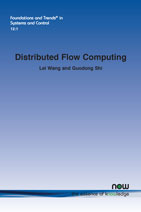Distributed Flow Computing
By Lei Wang, Zhejiang University, China, lei.wangzju@zju.edu.cn | Guodong Shi, The University of Sydney, Australia, guodong.shi@sydney.edu.au
Abstract
Distributed computing seeks to solve global problems without a central coordinator, for physically decentralized agents holding local and private data over a communication network. This monograph provides an overview of continuous flows as distributed solvers for linear algebraic equations, linear matrix equations, constrained convex optimization, and Nash equilibrium seeking, highlighting the interface between graph theory, control systems, and optimization.
Distributed Flow Computing
Network systems of interconnected agents arise from several important applications such as smart power grids, swarm robotics, autonomous driving and intelligent transportation, and machine learning. Each agent in such systems may represent a renewable power generator, an autonomous vehicle, or a local data center. The agents possess local decisions and objectives and communicate with each other via wired or wireless communications. Distributed algorithms seek to compute a system-level solution defined at the network level through coordinated decisions over the communication network. The promise is drastically improved scalability, robustness, and resilience for optimization and computation in large-scale systems. Distributed computing seeks to solve global problems without a central coordinator, for physically decentralized agents holding local and private data over a communication network.
This monograph provides an overview of continuous flows as distributed solvers for linear algebraic equations, linear matrix equations, constrained convex optimization, and Nash equilibrium seeking, highlighting the interface between graph theory, control systems, and optimization.
